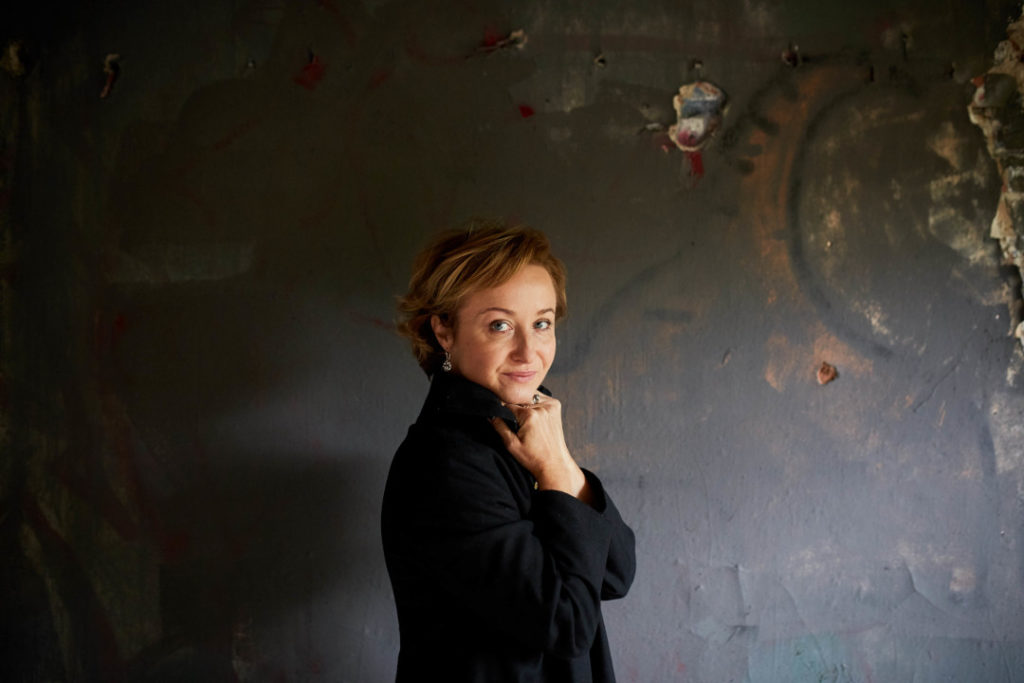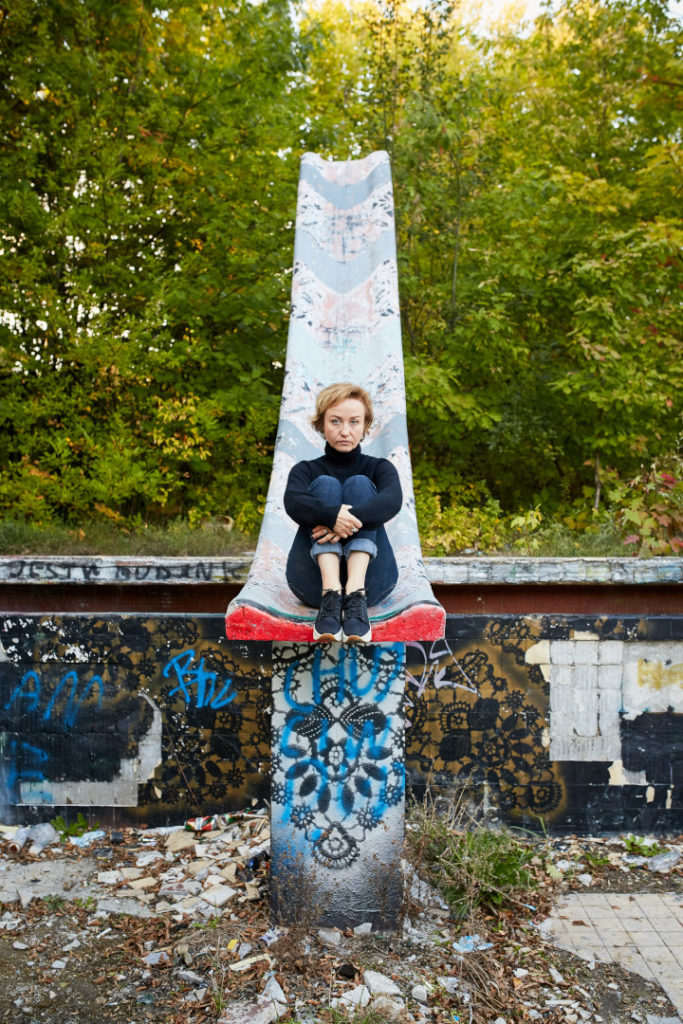Traces
The past constantly vibrates in Gabriela Muskała’s head. The actress has just stared in Marek Koterski’s 7 feelings (7 uczuć) and is impatiently waiting for the premiere of The Fugues (Fugi) by Agnieszka Smoczyńska. She invited us for a walk to her beloved childhood town Ołdrzychowice Kłodzkie and to Warsaw, where we visited Wilanów and the swimming pool area Skry. Unnoticed, banal spaces turn into a reservoir of mysterious recollections hidden in the memory.
By: Marcin Radomski
Photos: Bartek Barczyk
Marcin Radomski: In Marek Koterski’s “7 feelings” you portray Weronka, the best student in the class. In this film, Adaś Miałczyński returns to the time of his childhood. And what was your time of growing up?
Gabriela Muskała: I was brought up in Kłodzko Valley in the village Ołdrzychowice Kłodzkie. It is one of the most picturesque areas, frequently visited by filmmakers. Imagine a winding river, a village that is almost 3 km long along it, and rolling hills – on the north side of the Golden Mountains range, on the southern Krowiarki Mountains, belonging to the Eastern Sudetes. In the village, post-German architecture has been preserved. Amazingly dark. Disturbingly blends into this rural–angelic picture.
There is a neo-Romanesque mausoleum from 1889 behind my house, where I had my Religion lessons. It accommodates the tombs of the Reich counts von Magnis, the previous owners of Ołdrzychowice. There are two black, cast iron figures of angels in front of the entrance. I remember that, as a petrified child, I was saving a little bird that fell into the crack between the slabs, straight into the underground corridors. There is also a beautiful parish church of St. John the Baptist next to my house. I had my first Communion and my Confirmation there, and I was singing in the village choir. An old post-German child cemetery survived behind the church. I used to sit there for many hours, surrounded by graves, observing the nature.

Your heroine from ‘7 feelings’, Weronka Porankowska, also lives in the village.
It is a tragic character, even though her behavior may seem to be funny and makes us laugh. Her ambition to be the best in everything doesn’t come out of her character, yet from her fear of her father – tyrant, who demands from her perfection. In every moment, when on this perfection is a scratch, Weronika bursts into panic, despair, is out her depth, she wants to run away but there is nowhere to.
Your protagonists from “7 feelings”, Weronka Porankowska, also lives in a village.
It is a tragic character; despite the fact that she behaves in a funny way and makes us laugh. Her ambition to be the best in everything doesn’t stem from her character, but from her fear of her father – a tyrant, who demands perfection. Every time, when there is a crack on her perfection, Weronika bursts into panic and despair, cannot breathe, looses ground, she wants to run away, but there is nowhere to go.
“Lower Silesia is a mix of colors and darkness, a land of melancholy and contrasts”.
And what about you, where did you run away to, when you felt unhappy?
For example, to an extensive park of a classicistic palace of the Magnis from the beginning of the 19th century. It is located about 100m from my house. My sister used to go there to school, later moved to a blocks of flats built in the ‘70s. It always surprises me to see multi-storey buildings in a village, certainly more suitable for a city landscape. This is a sad view. However, that’s how the ‘70s looked like in Poland. The beautiful palace of the Magnis in Ołdrzychowice, where the Prussian queen Luiza once spend a night on her way to a treatment in Lądek Zdrój, was burglarized by the Russians during the war. It hasn’t been renovated since then. The building has deteriorated with years. Today all we have left is a sad shell.
If there was a competing for the most mysterious and grey voivodeship, would Lower Silesia have a chance to win?
Mysterious – yes. Grey – I disagree – it is associated with being bland, and to me Lower Silesia and its architecture definitely isn’t bland. It is a mix of colors and darkness, a land of melancholy and contrasts. Kłodzko, where I was born and where I went to a musical school and Bolesław Chrobry high school, is similar. My parents worked in a hospital there. There were 12 km from our house in Ołdrzychowice to Kłodzko. The village has significantly changed after the flood in 1997. My kindergarten teacher saw, through the window on the upper floor, old lindens floating away, standing… with slopes. It was a specific end of the old world.

What do you feel when you come back home?
I’ll show you pictures, you’ll see for yourself. [Gabriela Muskała shows me photos of an old railway station, swings, a church and health centre, where she lived]. I feel the same as every adult who comes back to the places of his/her childhood. They will remain magical forever. It doesn’t matter if it’s a ruin, a block, a villa or a farmstead. A child is able of creating own world everywhere.
What was yours?
It still greatly inspires me. For me, as an actress and a writer, memories from my childhood are priceless. I was too sensitive and displayed my emotions. I loved animals, I ran through meadows, my neighbors’ sheds, I saved birds that had fallen out of their nests, kittens who were to be drowned, frogs that my friends tried to kill… I used to come back home with that entire menagerie and with tears in my eyes, and in a high – pitched voice, in the speed of the light, I used to try to convince my mum that we must look after all of them.
I debuted on stage as Anne from “Anne of Green Gables” in the Jaracz Theatre in Łódź. I didn’t like this character when I was a child – we were too alike. As an actress, I fell in love with her during rehearsals. All I had to do is reach to my childhood memories, remind myself of all those emotions not yet shielded by adolescence… and I was Anne, I didn’t have to play her. However, this was the very beginning of my acting journey, I was very young. In Marek Koterski’s film I could go back to childhood as a grownup woman.
Was participation in “7 feelings” special?
In every respect – artistic and personal. Being on a set with Marek, I appreciated how beautiful my job is. We could be children again. That’s the task Marek gave us. Not to play a child, but to be one. And it was a liberating experience – regardless of the type of emotions of our screen children – happy, funny, or dramatic and devastating. We could go back to the childhood that is lost forever to everyone who enters adulthood. People are left only with memories and – as we know – memory twists them a lot.

“The Fugues” by Agnieszka Smoczyńska tells about imperfection of memory. You wrote the script and you played the main part. Where did the idea for the story come from?
I was watching a TV program “Whoever saw, whoever knows” and I saw a woman who didn’t know what her name was and where she came from. From had been staying in a psychiatric hospital in Warsaw for some time, where she was found. A man called the program and said that he used to be her neighbor and that she had a husband and children, with whom she used to live in a village in the Kujavian – Pomeranian voivodeship. The woman was shocked. She didn’t remember any of it. She didn’t remember she was a mother. I was sitting in front of my TV shocked as much as she was, and from that very moment I knew that I want to write a script about her.
“I like places that have many layers, where the past mixes with the present”.
In the first scene Alicja comes out from a tunnel at the central railway station in Warsaw. She has no idea where she is. The protagonist of the film wakes up on the tracks in the middle of the forest, not knowing who she is and where to go, so she gets up and follows these tracks. This way she gets to the central railway station in Warsaw. She climbs up to the platform and surprises passengers standing there. They got there the “regular way” – from the city, from their homes, streets, and escalators in the station. She comes out from the tunnel, from which trains come, she is different.
Why?
She suffers from a dissociation fugue, she doesn’t remember any of her experiences, she loses her memories and the knowledge of the past, her personal memory. It brings about an entire transformation of personality. In case of dissociation fugues, i.e. someone who didn’t like loud music suddenly only listens to hard rock, and someone who was extrovert becomes introvert. In order to discover the truth about herself, the protagonist will have to confront her past.
How does space in “The Fugues” impacts acting?
The film director Agnieszka Smoczyńska gathered an amazing crew. The set design by Jagna Dobesz is the best example of how space and interiors can tell a story of protagonists, complement their relations, and reflect their emotions. The same can be said about Kuba Kijowski’s photos. When I was watching the film, I had the impression that the camera was inside Alicja’s heart. The space and photos equally build up the mystery of the protagonist of “The Fugues”. There’s no need of telling how her childhood looked like – it is sufficent to enter her parents’ house. It is a private building, placed not far away from the WuWa estate in Wrocław – an amazing architectural pearl from ‘70s. There is an atrium with a giant palm tree inside the building, which has been growing there from many years and now it almost breaks the ceiling. It’s quite an absurd view. This palm tree is a symbol of life that grows up when – paradoxically – the life of small Alicja was suppressed in the house.
We filmed many scenes in the model WuWa estate, i.e. in the Szaruna Hotel – it’s largest realization. This modernistic, extraordinary, functional, esthetic and “intelligent” housing estate from the end of the ‘20s has beautifully designed parks and protects the intimacy of its residents. These needs have been completely forgotten by modern architects.
However, Alicja’s house under the mountain Ślęża was different, a more modern version of her childhood home. It stood alone in a forest, glazed, seemingly open to space. However, inside it was gloomy and unfriendly. As we uncover the following fragments of the mystery of the protagonist, we have an impression that the glass covering the house is armor, with a task not to be open to the world, but to provide total isolation.
Mount Ślęża, which can be seen through Alicja’s window is located 34 km to the south – west from Wrocław. It has 718 m and, if we were to believe the legends, it has the gates to hell at the bottom. It is a place of cult with, supposedly, the strongest chakras in Poland. On the other hand, there is a catholic church situated at the top of the mountain. The mountain seems to be hard to climb. It resembles a person who lied down on his belly during pray. This character has outstanding strength and anxiety. Alicja’s leaving in the direction of the mountain has an ambiguous and symbolic dimension.

Let’s move to Warsaw, where you have moved out after your studies in the Film School in Łódź. Do you remember your first years in the capital city?
It was 16 years ago. I lived in Old Wilanów for the first 10 years. In a block of flats that had 11 floors. It was before the Wilanów estate was built, with the so-called “lemon squeezer” in the centre – the Temple of Divine Providence. In 2002 there were still broad, empty green areas. I used to jog there, walk my dog. Being brought up in a village, I looked everywhere for green space.
The first years in the city were harsh for me. In Łódź I lived on Retkinia, where after leaving the estate and crossing the street I would enter a forest. When they started building “a city inside a city” in Wilanów I felt suffocated and decided to search for a new place. Six years ago I moved to the upper Old Mokotów, next to the park Mokotowskie Field. It is my asylum. I live in an old tenement house from 1931, which has traces of bullets from WWII in the gate. Every time I open the gate, it gives me shivers. The city remembers its history.
What is your favorite place in Warsaw?
I have a few. I like places that have many layers, where the past mixes with the present. Near my home, on Mokotowskie Field, there is a brilliant area of old swimming pools Skry. The buildings have been closed for over 20 years. They do not remind us of the times of splendor when they were crowded during the season. RKS Club Skra swimming pools were opened in August 1973. The complex was closed in the ‘90s because of financial problems. Now there are a few empty swimming pools of different sizes on the 7-hectare area. However, by looking at old vandalized changing rooms and showers one can see some traces of postwar modernism. Nowadays the entire area is covered by wild nature, graffiti and the homeless. A place once dead found its new function; it is fulfilled with new life.




